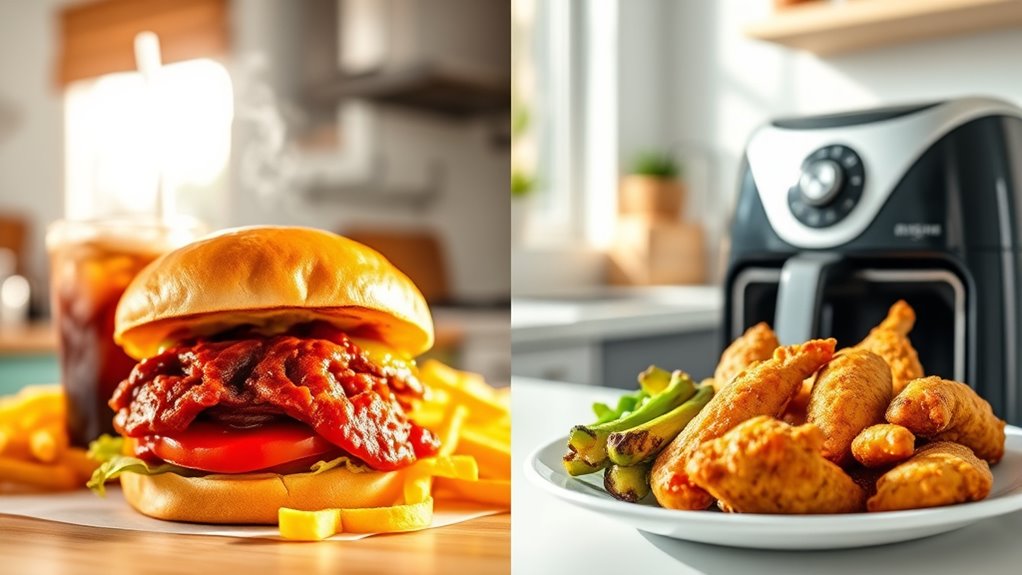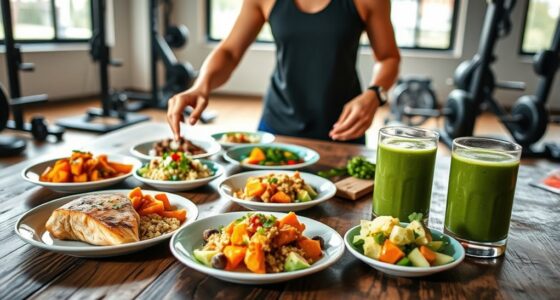Switching from fast food to air frying helps you enjoy crispy, flavorful meals with less unhealthy fats and calories. By replacing fried snacks and high-calorie fast foods with air-fried vegetables, lean proteins, and homemade snacks, you can make healthier choices without sacrificing taste. Using your air fryer regularly and experimenting with new recipes makes sticking to your goals easier. Keep exploring ways to improve your habits—more tips and tricks await to support your journey.
Key Takeaways
- Gradually replace fried fast foods with air-fried versions to reduce unhealthy fats and calorie intake.
- Incorporate nutrient-dense ingredients like vegetables, lean proteins, and healthy fats into your meals.
- Plan and prep meals ahead to avoid impulsive fast food choices and support healthier eating habits.
- Use healthier oils such as olive or avocado oil when air frying to enhance nutritional value.
- Experiment with new recipes and culinary techniques to keep healthy meals flavorful and satisfying.
Understanding the Benefits of Air Frying

Air frying has become popular because it offers a healthier way to enjoy your favorite crispy foods without sacrificing flavor. Instead of deep-frying in oil, an air fryer uses hot air circulation to cook food evenly and create a crispy exterior. This method considerably reduces your intake of unhealthy fats and calories, helping you maintain a balanced diet. You’ll find that dishes like fries, chicken wings, and vegetables turn out just as delicious with less oil. Plus, air frying is quick and convenient, making it easier to prepare tasty, wholesome meals at home. By choosing this method, you’re taking a step toward better health without giving up the crunch and satisfaction you love. Additionally, understanding the proper air fryer usage tips can help you achieve perfect results every time. Incorporating healthier cooking techniques like air frying can also be complemented by understanding nutritional advantages of green juice, which provides essential vitamins and antioxidants to support your wellness journey. Using top-quality air fryers can further enhance your cooking experience and ensure consistent results.
Identifying Common Fast Food Culprits
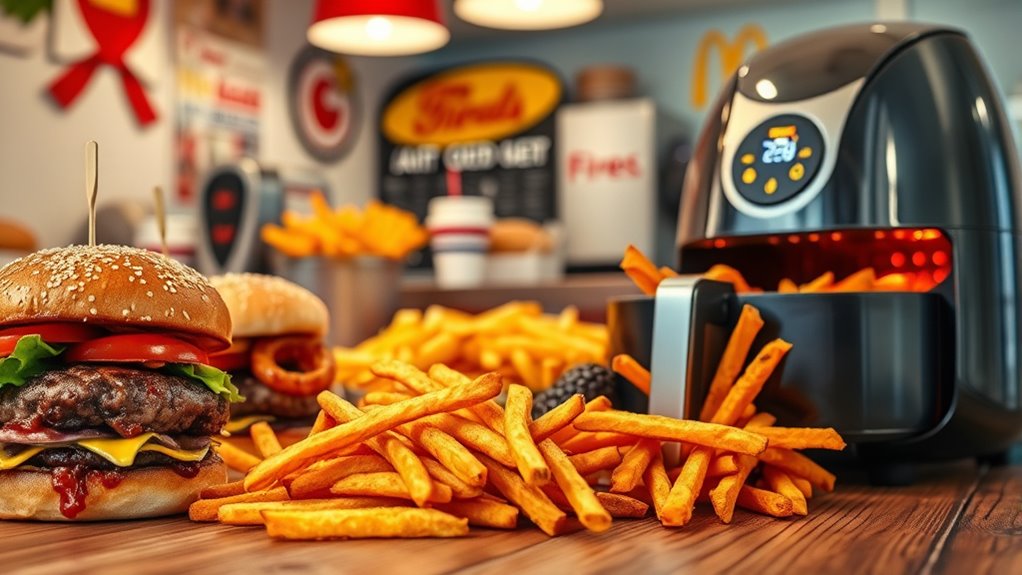
Fast food often hides behind high-calorie burgers and fries that pack on unnecessary energy. Sugary beverages and sweets make it easy to consume excess sugar without realizing it. Fried snacks and appetizers are tempting but can quickly derail your health goals if you’re not careful. Incorporating sound design techniques such as auditory cues can also help reinforce healthy eating habits by creating positive associations with nutritious foods.
High-Calorie Burgers and Fries
Many popular fast food options pack a high calorie punch, especially when it comes to burgers and fries. A single burger can contain over 800 calories, mainly from beef, cheese, and sauces. Fries add another 300-500 calories depending on portion size and cooking method. To see how these items compare, check out this table:
| Item | Calories | Key Ingredient |
|---|---|---|
| Cheeseburger | 750-900 | Beef, cheese, bun |
| Large Fries | 400-500 | Potatoes, oil |
| Double Bacon Burger | 1000+ | Extra beef, bacon |
These foods contribute heavily to calorie intake, making it easy to overeat without realizing. Reducing portion sizes or choosing healthier alternatives helps you move toward a healthier lifestyle. Incorporating balanced meal planning can further support your dietary goals. Additionally, understanding electric bike speeds can help you choose the right model for your commuting needs.
Sugary Beverages and Sweets
Sugary beverages and sweets are some of the most common culprits behind hidden calorie intake at fast food restaurants. You might order a soda or a milkshake, unaware that these drinks can add hundreds of empty calories to your meal. Likewise, desserts like cookies, pies, or candy often seem small but pack a high sugar content. These items don’t satisfy your hunger and provide little nutritional value, making it easy to overconsume calories without realizing it. Drinking sugary drinks regularly can spike your blood sugar and lead to weight gain over time. Instead, opt for water, flavored seltzers, or unsweetened tea. For sweets, try fresh fruit or small portions of healthier options to satisfy your cravings without sabotaging your health goals. Incorporating mindful decluttering into your routine can help you better organize healthy snacks and prevent impulsive choices, supporting your overall wellness journey. Being aware of nutritional content in your food choices can further empower you to make healthier decisions and avoid hidden sugars and calories. Additionally, understanding tea brewing techniques can inspire healthier beverage choices that are both satisfying and low in calories. Recognizing sugar content in your favorite treats can help you manage intake and choose smarter alternatives.
Fried Snacks and Appetizers
Have you ever noticed how crispy fried snacks and appetizers can quickly add up in calories without satisfying your hunger? Items like fried onion rings, mozzarella sticks, and chicken wings are common fast food culprits. They often tempt you with their crunch but pack excessive fat and calories. To understand their impact, consider this table:
| Snack | Calories (per serving) | Healthier Alternative |
|---|---|---|
| Fried Onion Rings | 150-200 | Baked onion rings |
| Mozzarella Sticks | 200-250 | Grilled cheese sticks |
| Chicken Wings | 70-100 per wing | Baked or air-fried wings |
Replacing fried options with baked or air-fried versions reduces unhealthy fat intake while still satisfying your cravings.
Tips for Transitioning to Air-Fried Meals
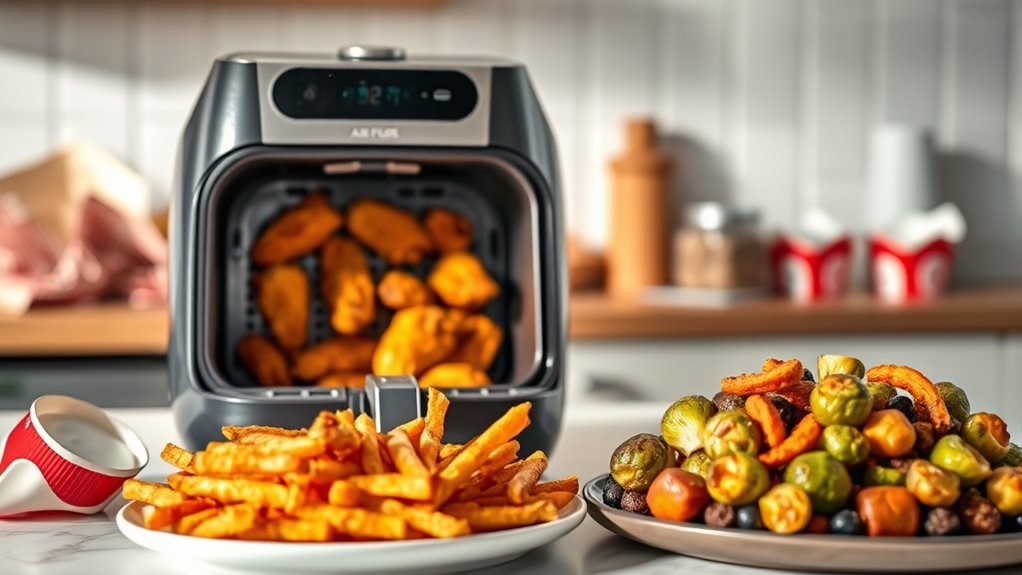
To start shifting to air-fried meals, try gradually replacing your traditional fats with healthier options like olive or avocado oil. Experiment with new recipes to find flavors you enjoy and keep things exciting. Remember to adjust cooking times and temperatures to get perfect results every time. Incorporating diverse culinary techniques can further enhance your healthy eating journey. Exploring different cooking methods such as air frying can help you achieve a variety of textures and flavors while maintaining a nutritious diet. Additionally, understanding how contrast ratio affects image quality can inspire you to optimize your food presentation for more appealing meals. Utilizing fresh ingredients can also boost the nutritional value and taste of your air-fried dishes.
Gradually Replace Traditional Fats
Switching from traditional fats to healthier alternatives doesn’t have to happen overnight. Start by slowly reducing the amount of butter, lard, or oil in your recipes. Instead, try swapping in healthier fats like olive oil, avocado oil, or nut butters. When cooking, use less oil overall, focusing on non-stick sprays or minimal amounts. Gradually, you’ll get used to the new flavors and textures, making the progression smoother. Keep in mind that small changes add up over time, so don’t stress about perfection. Read labels carefully to choose products with healthier fat profiles. Over weeks, your taste buds will adjust, and you’ll find it easier to incorporate these fats into your daily meals. This steady shift will support your goal of a healthier lifestyle without feeling overwhelming. Additionally, exploring sustainable farming practices can ensure you’re making choices that benefit both your health and the environment. Understanding production quantity variance can help you better manage your food budgets and reduce waste as you experiment with healthier ingredients. Incorporating healthy fats into your diet can also improve your overall energy levels and help you feel more satisfied after meals. Moreover, being aware of AI security vulnerabilities highlights the importance of staying informed and cautious when adopting new health technologies or apps.
Experiment With New Recipes
Trying out air-fried recipes is an effective way to enjoy your favorite crispy foods with less oil. Start by exploring simple recipes like crispy chicken wings, roasted vegetables, or even potato chips. Don’t be afraid to get creative—try new seasonings, marinades, or coatings to add variety. Use cookbooks or online resources dedicated to air frying for inspiration. Keep a recipe journal to note what works best and tweak ingredients to suit your taste. Remember, experimenting is part of the process; you might need a few tries to perfect your favorites. As you gain confidence, gradually introduce more complex dishes. This approach keeps your meals exciting and helps you *switch* smoothly to healthier, air-fried options.
Adjust Cooking Times and Temps
Adjusting cooking times and temperatures is essential when shifting to air-fried meals, as they often differ from traditional methods. Air fryers cook faster and tend to produce crispier results with less oil, so you’ll need to modify your usual settings. Start by reducing the temperature by about 25°F from your usual oven or pan-fried recipes. Check your food early to avoid overcooking, especially for delicate items like vegetables or thin cuts of meat. Keep an eye on the timer, as air fryers often require less cooking time—usually 20-30% less. Use a food thermometer to ensure proper doneness, and don’t be afraid to tweak times with each new recipe. With practice, you’ll find the perfect balance for healthier, delicious air-fried meals. Understanding tuning can help you further optimize your cooking process for specific recipes, especially when considering the unique features of air fryers such as rapid heat transfer and airflow circulation. Being mindful of air fryer maintenance can also help sustain consistent cooking performance over time. Additionally, incorporating cooking techniques tailored to the air fryer can improve your results and efficiency.
Essential Air Fryer Techniques and Settings
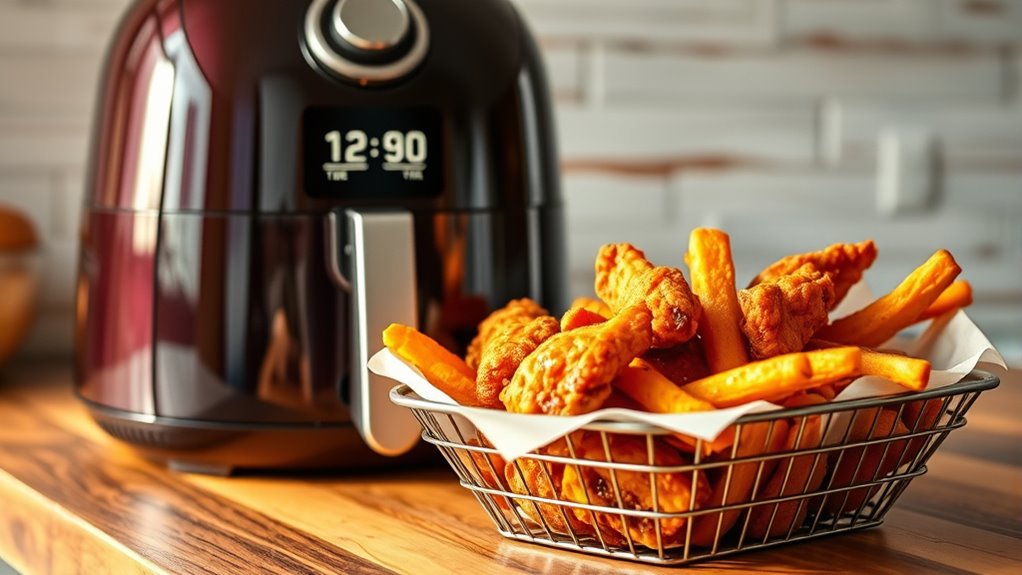
Mastering your air fryer starts with understanding its vital techniques and settings. First, familiarize yourself with the temperature range, typically from 180°F to 400°F. Use lower temperatures for gentle crisping or reheating, and higher temps for browning and crispy textures. Preheating is essential; it ensures even cooking and better results, usually taking 3-5 minutes. Shake or flip food halfway through cooking to promote uniform browning. Use the timer accurately—most recipes benefit from a precise setting to avoid overcooking. Many air fryers have specific presets for common foods like fries or chicken; use these as guides but adjust based on your preferences. Additionally, understanding the air circulation technology can help you optimize your cooking results and maintain the appliance effectively. Proper food placement is crucial to allow hot air to circulate properly, ensuring consistent crispiness and doneness. Lastly, avoid overcrowding the basket, allowing hot air to circulate freely for crisp, evenly cooked dishes.
Healthy Ingredients and Recipes to Try
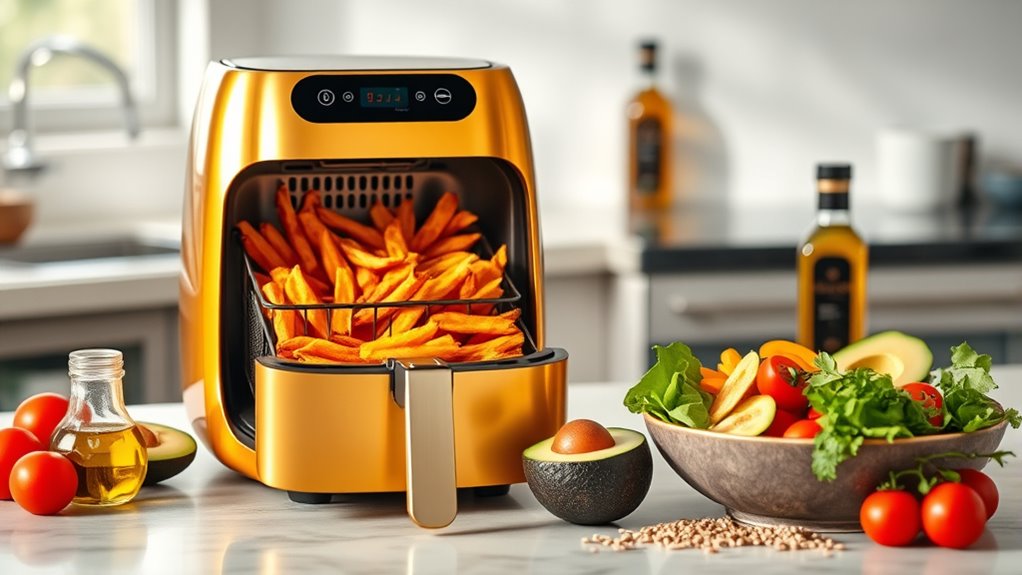
Discover how nutrient-dense superfoods can boost your meals with essential vitamins and minerals. Swap out common ingredients for healthier options and experiment with flavorful spice blends to enhance taste. These simple changes make your recipes both delicious and nourishing.
Nutrient-Dense Superfoods
Nutrient-dense superfoods pack a powerful punch of vitamins, minerals, and antioxidants that can boost your health and energy levels. Incorporating these foods into your diet helps support your immune system, improve digestion, and promote overall wellness. Think vibrant berries like blueberries and acai, which are rich in antioxidants that fight free radicals. Leafy greens such as kale and spinach supply iron, calcium, and fiber essential for your body’s functions. Seeds and nuts like chia, flaxseed, and almonds provide healthy fats and protein. Adding these superfoods to smoothies, salads, or snacks makes it easy to boost nutrition without sacrificing taste. Start small by replacing processed snacks with nutrient-dense options, and watch your energy and vitality improve over time.
Creative Ingredient Swaps
Creative ingredient swaps are a simple way to make your meals healthier without sacrificing flavor. Instead of using refined white flour, try whole wheat or almond flour for added fiber and nutrients. Swap sour cream with Greek yogurt to boost protein and reduce fat. Replace sugar with natural sweeteners like honey or maple syrup, which offer more nutrients and a lower glycemic index. Use cauliflower rice or spiralized vegetables instead of traditional pasta to cut carbs and increase vegetable intake. Opt for olive oil or avocado instead of butter for healthier fats. Incorporate mashed sweet potatoes or mashed bananas in baked goods as healthier alternatives to butter or sugar. These small changes can markedly improve your meals while keeping them delicious and satisfying.
Flavorful Spice Blends
Have you ever wondered how a simple spice blend can transform a bland dish into a flavorful, healthful meal? Spice blends are your secret weapon for adding depth without extra calories or sodium. They’re easy to make and customize to your taste. Here are four must-try mixes:
- Taco Seasoning – Combine cumin, paprika, garlic powder, and chili powder for a versatile, smoky flavor.
- Herb Blend – Mix dried basil, oregano, thyme, and rosemary to brighten salads and roasted veggies.
- Curry Powder – Blend turmeric, coriander, cumin, and ginger for warmth and depth in stews and rice.
- Smoked Paprika Mix – Add smoked paprika, garlic powder, onion powder, and a pinch of cayenne for a smoky kick.
These blends boost flavor and health benefits, making every meal exciting.
Replacing Favorite Deep-Fried Snacks
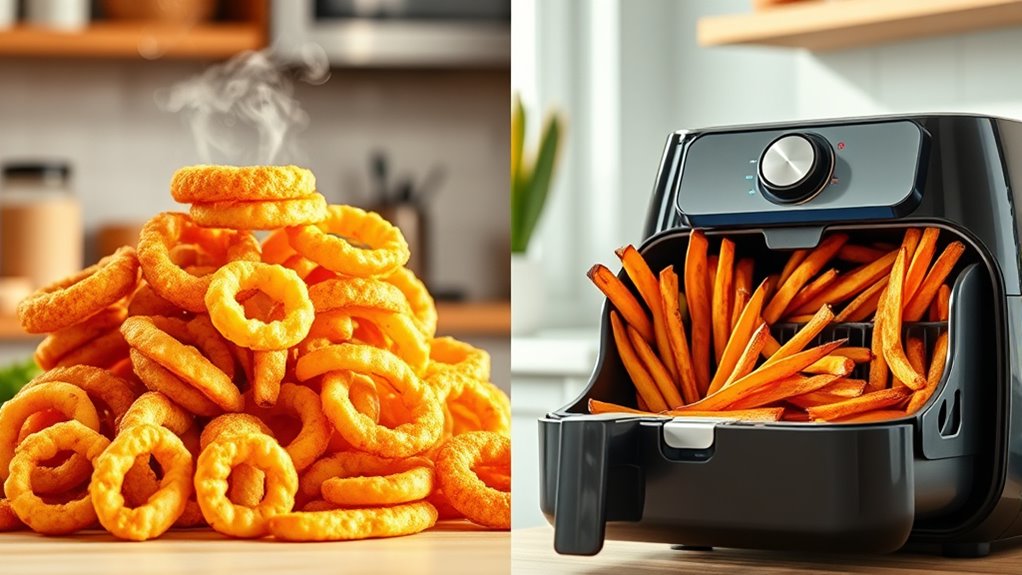
If you’re craving the crispy texture and savory taste of your favorite deep-fried snacks, there are healthier alternatives that can satisfy your cravings without sacrificing flavor. Instead of traditional fries or chicken wings, try baking or air frying vegetables like zucchini, sweet potatoes, or cauliflower. These options deliver crunch and flavor with less oil and fewer calories. You can also make homemade versions of onion rings or mozzarella sticks using whole-grain coatings and minimal oil. For a quick snack, roasted chickpeas seasoned with your favorite spices provide a crunchy, protein-packed alternative. These swaps reduce fat intake and increase nutrient density, helping you enjoy the textures and tastes you love while supporting your health goals.
Meal Planning for a Healthier Lifestyle
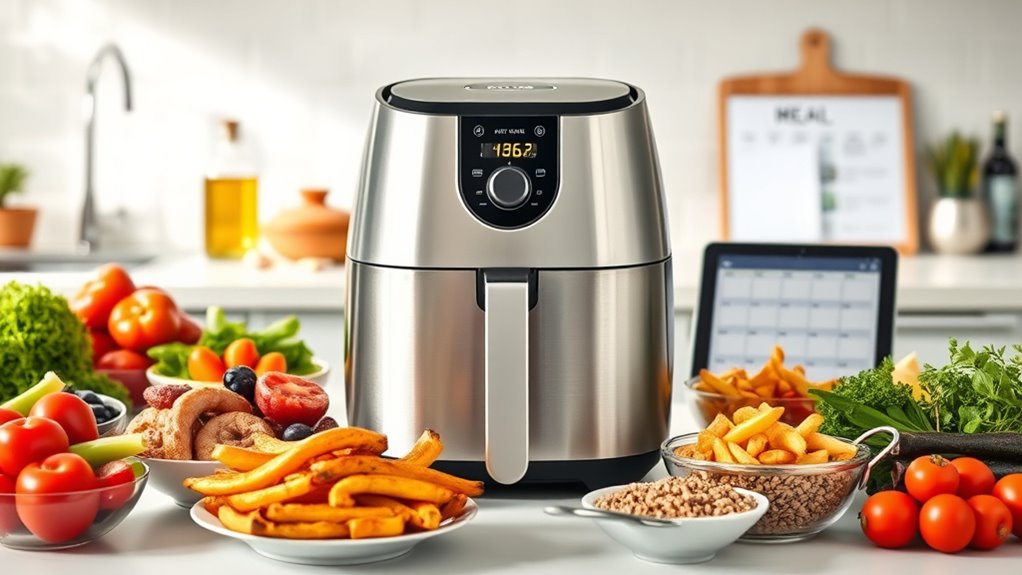
Effective meal planning is key to maintaining a healthier lifestyle, as it helps you make mindful food choices and avoid last-minute unhealthy options. When you plan ahead, you guarantee balanced meals and prevent impulsive fast-food runs. Start by creating a weekly menu, focusing on nutrient-rich ingredients. Next, make a shopping list based on your plan to avoid unnecessary purchases. Consider batch cooking or prepping ingredients in advance to save time during busy days. Finally, stay flexible—adjust your plan as needed but stick to your healthy goals.
- Map out your weekly meals.
- Shop with a detailed list.
- Prep ingredients in advance.
- Keep your plan adaptable.
Overcoming Challenges During the Transition
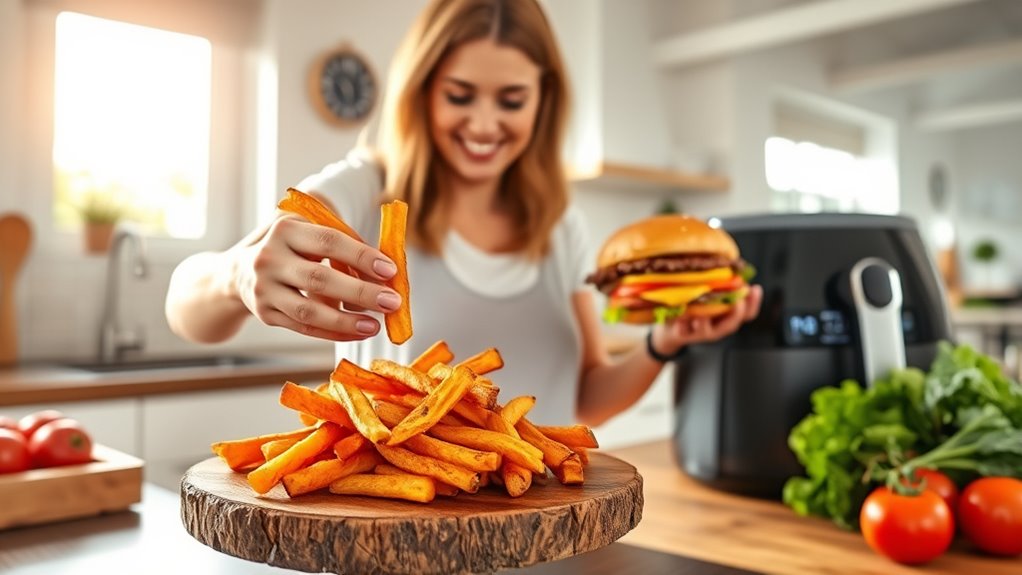
Switching to a healthier lifestyle often brings unexpected obstacles, but recognizing these challenges early can help you stay motivated. You might face cravings, time constraints, or social pressures that make change difficult. To tackle these, identify potential hurdles and plan solutions in advance. For example, prepare quick healthy snacks or communicate your goals to friends.
| Challenge | Solution | Tip |
|---|---|---|
| Cravings for junk food | Find healthy alternatives | Keep fruit handy |
| Time constraints | Batch cook and plan meals | Use meal prep Sundays |
| Social pressure | Share your goals with friends | Invite friends to join |
Being aware of obstacles helps you adapt, ensuring your progression is smoother and more sustainable.
Incorporating More Vegetables and Lean Proteins
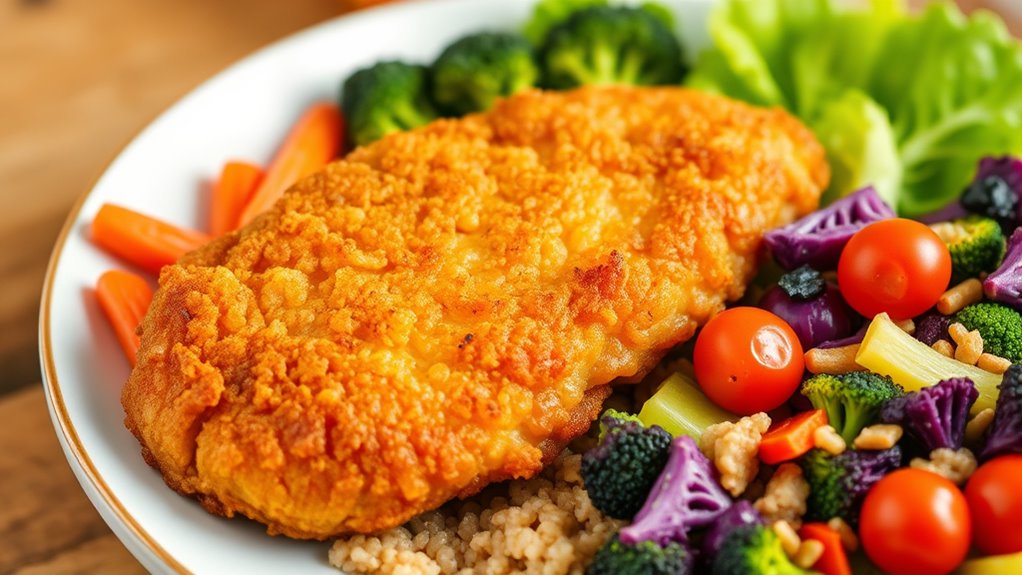
Adding more vegetables and lean proteins to your diet can considerably boost your health and energy levels. These nutrient-dense foods help you feel fuller longer and support muscle growth and immune function. To get started, consider these tips:
- Incorporate leafy greens like spinach or kale into your meals daily.
- Swap out processed meats for lean options such as chicken breast, turkey, or fish.
- Add colorful vegetables like bell peppers, carrots, and broccoli to your stir-fries and salads.
- Prepare snacks with hummus, Greek yogurt, or nuts to increase protein intake between meals.
Maintaining Your New Healthy Eating Habits
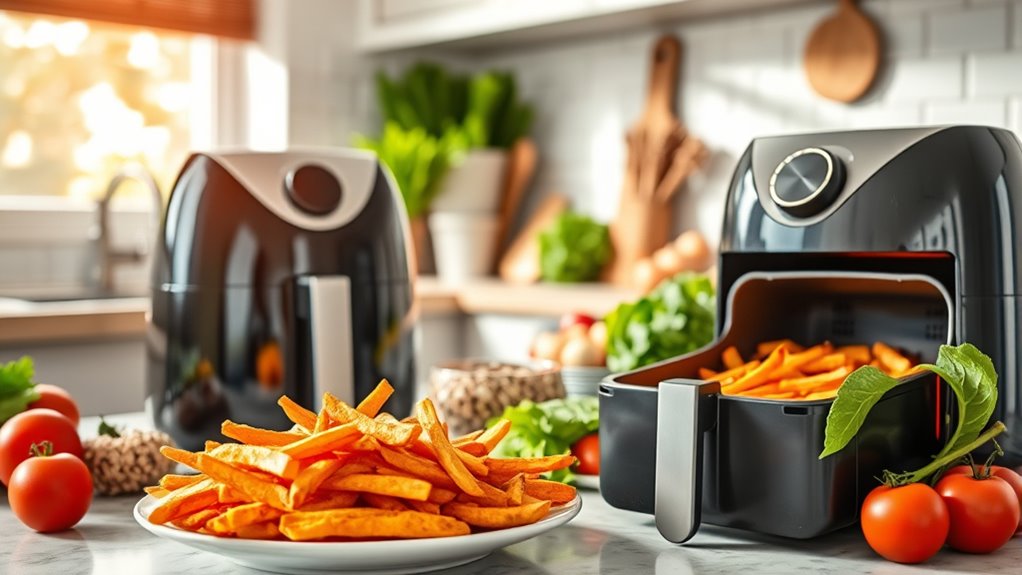
Once you’ve made healthy eating a regular part of your routine, the challenge shifts to maintaining those habits over time. To stay on track, focus on consistency and adaptability. Planning meals ahead helps prevent impulsive choices, while keeping healthy snacks accessible reduces temptation. Celebrate small victories to stay motivated, and don’t be too hard on yourself if you slip up—just get back on track. Use this table to identify your key strategies:
| Strategy | Action Step | Benefit |
|---|---|---|
| Meal Planning | Prepare weekly menus | Avoid last-minute unhealthy choices |
| Smart Shopping | Shop the perimeter of the store | Pick fresh, whole foods |
| Stay Accountable | Share goals with friends or family | Boosts motivation |
| Flexibility | Adjust meals as needed | Prevents burnout |
| Track Progress | Keep a food journal | Recognize patterns and improvements |
Frequently Asked Questions
How Can I Make Air-Fried Meals More Flavorful Without Added Fats?
You want your air-fried meals to be more flavorful without added fats. To do that, try marinating your ingredients with herbs, spices, and citrus juices before cooking. Use flavorful seasonings like garlic powder, paprika, or cumin to boost taste. You can also add a splash of low-sodium soy sauce or balsamic vinegar for extra depth. These tricks help enhance flavor naturally while keeping your meals healthy and delicious.
Are Air Fryers Suitable for Cooking All Types of Foods?
Did you know that 85% of home cooks find air fryers versatile for various dishes? You might wonder if they’re suitable for all foods. The truth is, air fryers excel with vegetables, meats, and even baked goods, but delicate items like soufflés or certain batters may not turn out perfect. So, while they’re versatile, understanding their limits helps you achieve the best results for different foods.
How Do I Prevent Food From Sticking in the Air Fryer?
To prevent food from sticking in your air fryer, start by lightly greasing the basket with cooking spray or a small amount of oil. Make sure to preheat the appliance before adding food. Avoid overcrowding the basket, so air circulates properly. Shaking or turning the food halfway through cooking also helps prevent sticking and ensures even browning. These simple steps keep your food from sticking and improve results.
What Are the Best Storage Methods for Air-Fried Leftovers?
You might think leftovers in the air fryer lose their crispiness, but proper storage keeps them fresh. Transfer leftovers to an airtight container or wrap them tightly with plastic wrap or foil. For best results, let food cool completely before storing. Label containers with dates, and consume within 2-3 days. Reheat in the air fryer to restore crunch, and avoid overcrowding to prevent sogginess.
Can Air Frying Help Reduce Overall Calorie Intake Long-Term?
Air frying can help you reduce calorie intake over time by allowing you to enjoy crispy foods without extra oils or fats. You actively choose healthier ingredients and cooking methods, making it easier to stick to a balanced diet. As you incorporate air frying into your routine, you’ll likely notice fewer calories consumed overall, supporting your long-term health goals while still satisfying your cravings for fried-style foods.
Conclusion
Think of your journey to healthier eating as steering a boat through changing waters. With each air-fried meal, you’re adjusting your sails, catching the breeze of better choices. As you navigate away from fast food storms, your habits settle into a calmer, steadier course. Keep steering with purpose, embrace the new horizons of nutritious ingredients, and soon, your lifestyle will glide smoothly into a brighter, healthier future.
